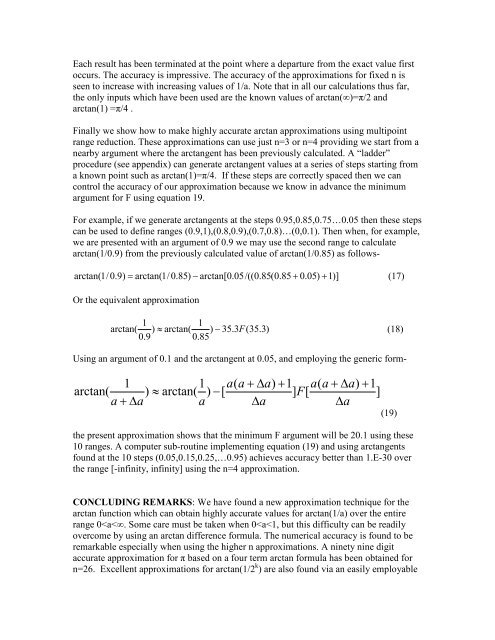ARCTAN-APPROX-PAPER
ARCTAN-APPROX-PAPER
ARCTAN-APPROX-PAPER
Create successful ePaper yourself
Turn your PDF publications into a flip-book with our unique Google optimized e-Paper software.
Each result has been terminated at the point where a departure from the exact value first<br />
occurs. The accuracy is impressive. The accuracy of the approximations for fixed n is<br />
seen to increase with increasing values of 1/a. Note that in all our calculations thus far,<br />
the only inputs which have been used are the known values of arctan(∞)=π/2 and<br />
arctan(1) =π/4 .<br />
Finally we show how to make highly accurate arctan approximations using multipoint<br />
range reduction. These approximations can use just n=3 or n=4 providing we start from a<br />
nearby argument where the arctangent has been previously calculated. A “ladder”<br />
procedure (see appendix) can generate arctangent values at a series of steps starting from<br />
a known point such as arctan(1)=π/4. If these steps are correctly spaced then we can<br />
control the accuracy of our approximation because we know in advance the minimum<br />
argument for F using equation 19.<br />
For example, if we generate arctangents at the steps 0.95,0.85,0.75…0.05 then these steps<br />
can be used to define ranges (0.9,1),(0.8,0.9),(0.7,0.8)…(0,0.1). Then when, for example,<br />
we are presented with an argument of 0.9 we may use the second range to calculate<br />
arctan(1/0.9) from the previously calculated value of arctan(1/0.85) as follows-<br />
arctan( 1/0.9) = arctan(1/ 0.85) − arctan[0.05/((0.85(0.85 + 0.05) + 1)]<br />
(17)<br />
Or the equivalent approximation<br />
1<br />
1<br />
arctan( ) ≈ arctan( ) − 35.3F(35.3)<br />
(18)<br />
0.9 0.85<br />
Using an argument of 0.1 and the arctangent at 0.05, and employing the generic form-<br />
1<br />
1 a(<br />
a + ∆a)<br />
+ 1 a(<br />
a + ∆a)<br />
+ 1<br />
arctan( ) ≈ arctan( ) −[<br />
] F[<br />
]<br />
a + ∆a<br />
a ∆a<br />
∆a<br />
the present approximation shows that the minimum F argument will be 20.1 using these<br />
10 ranges. A computer sub-routine implementing equation (19) and using arctangents<br />
found at the 10 steps (0.05,0.15,0.25,…0.95) achieves accuracy better than 1.E-30 over<br />
the range [-infinity, infinity] using the n=4 approximation.<br />
(19)<br />
CONCLUDING REMARKS: We have found a new approximation technique for the<br />
arctan function which can obtain highly accurate values for arctan(1/a) over the entire<br />
range 0


